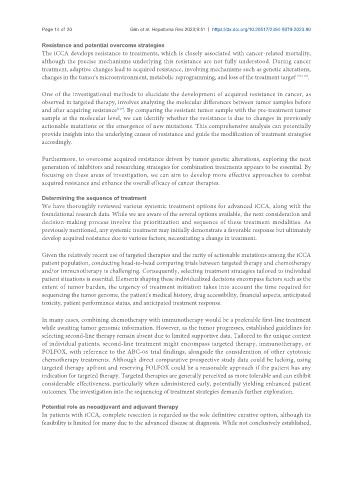Page 185 - Read Online
P. 185
Page 14 of 20 Gim et al. Hepatoma Res 2023;9:51 https://dx.doi.org/10.20517/2394-5079.2023.90
Resistance and potential overcome strategies
The iCCA develops resistance to treatments, which is closely associated with cancer-related mortality,
although the precise mechanisms underlying this resistance are not fully understood. During cancer
treatment, adaptive changes lead to acquired resistance, involving mechanisms such as genetic alterations,
changes in the tumor's microenvironment, metabolic reprogramming, and loss of the treatment target [115,116] .
One of the investigational methods to elucidate the development of acquired resistance in cancer, as
observed in targeted therapy, involves analyzing the molecular differences between tumor samples before
[117]
and after acquiring resistance . By comparing the resistant tumor sample with the pre-treatment tumor
sample at the molecular level, we can identify whether the resistance is due to changes in previously
actionable mutations or the emergence of new mutations. This comprehensive analysis can potentially
provide insights into the underlying causes of resistance and guide the modification of treatment strategies
accordingly.
Furthermore, to overcome acquired resistance driven by tumor genetic alterations, exploring the next
generation of inhibitors and researching strategies for combination treatments appears to be essential. By
focusing on these areas of investigation, we can aim to develop more effective approaches to combat
acquired resistance and enhance the overall efficacy of cancer therapies.
Determining the sequence of treatment
We have thoroughly reviewed various systemic treatment options for advanced iCCA, along with the
foundational research data. While we are aware of the several options available, the next consideration and
decision-making process involve the prioritization and sequence of these treatment modalities. As
previously mentioned, any systemic treatment may initially demonstrate a favorable response but ultimately
develop acquired resistance due to various factors, necessitating a change in treatment.
Given the relatively recent use of targeted therapies and the rarity of actionable mutations among the iCCA
patient population, conducting head-to-head comparing trials between targeted therapy and chemotherapy
and/or immunotherapy is challenging. Consequently, selecting treatment strategies tailored to individual
patient situations is essential. Elements shaping these individualized decisions encompass factors such as the
extent of tumor burden, the urgency of treatment initiation takes into account the time required for
sequencing the tumor genome, the patient's medical history, drug accessibility, financial aspects, anticipated
toxicity, patient performance status, and anticipated treatment response.
In many cases, combining chemotherapy with immunotherapy would be a preferable first-line treatment
while awaiting tumor genomic information. However, as the tumor progresses, established guidelines for
selecting second-line therapy remain absent due to limited supportive data. Tailored to the unique context
of individual patients, second-line treatment might encompass targeted therapy, immunotherapy, or
FOLFOX, with reference to the ABC-06 trial findings, alongside the consideration of other cytotoxic
chemotherapy treatments. Although direct comparative prospective study data could be lacking, using
targeted therapy upfront and reserving FOLFOX could be a reasonable approach if the patient has any
indication for targeted therapy. Targeted therapies are generally perceived as more tolerable and can exhibit
considerable effectiveness, particularly when administered early, potentially yielding enhanced patient
outcomes. The investigation into the sequencing of treatment strategies demands further exploration.
Potential role as neoadjuvant and adjuvant therapy
In patients with iCCA, complete resection is regarded as the sole definitive curative option, although its
feasibility is limited for many due to the advanced disease at diagnosis. While not conclusively established,

